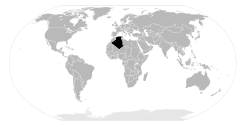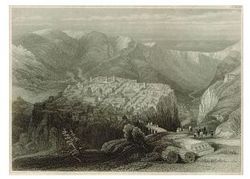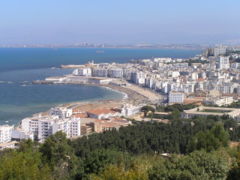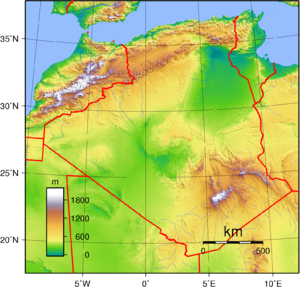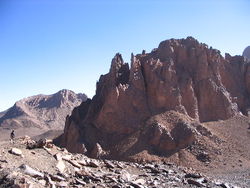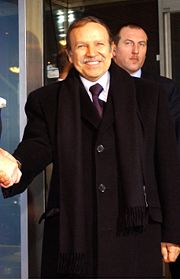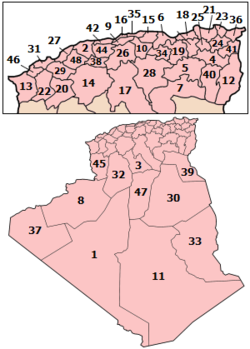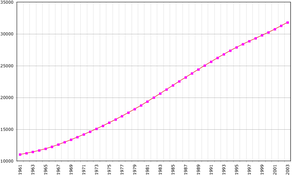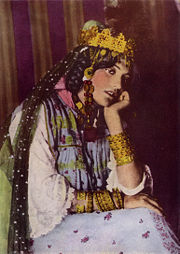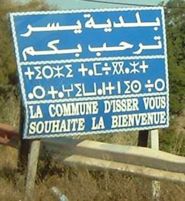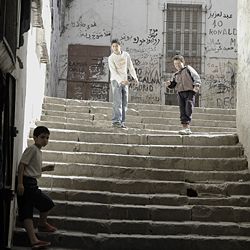Algeria
2008/9 Schools Wikipedia Selection. Related subjects: Africa; African Countries
| الجمهورية الجزائرية الديمقراطية الشعبية Al-Jumhūrīyah al-Jazā’irīyah ad-Dīmuqrāṭīyah ash-Sha’bīyahRépublique Algérienne Démocratique et Populaire People's Democratic Republic of Algeria
|
||||||
|---|---|---|---|---|---|---|
|
||||||
| Motto: من الشعب و للشعب (Arabic) "From the people and for the people" |
||||||
| Anthem: Kassaman (Arabic) The Pledge |
||||||
|
|
||||||
| Capital (and largest city) |
Algiers |
|||||
| Official languages | Arabic | |||||
| Recognised regional languages | Berber, French | |||||
| Demonym | Algerian | |||||
| Government | Presidential Republic | |||||
| - | President | Abdelaziz Bouteflika | ||||
| - | Prime Minister | Ahmed Ouyahia | ||||
| Establishment | ||||||
| - | Hammadid dynasty | from 1014 | ||||
| - | Ottoman rule | from 1516 | ||||
| - | French rule | from 1830 | ||||
| - | Independence from France | July 5, 1962 | ||||
| Area | ||||||
| - | Total | 2,381,740 km² ( 11th) 919,595 sq mi |
||||
| - | Water (%) | negligible | ||||
| Population | ||||||
| - | 2007 estimate | 33,333,216 ( 35th) | ||||
| - | 1998 census | 29,100,867 | ||||
| - | Density | 14/km² ( 196th) 36/sq mi |
||||
| GDP ( PPP) | 2006 estimate | |||||
| - | Total | $253.4 billion ( 38th) | ||||
| - | Per capita | $8,100 (2007 est.) ( 88th) | ||||
| GDP (nominal) | 2007 estimate | |||||
| - | Total | $131.026 billion ( 48th) | ||||
| - | Per capita | $3,825 ( 84th) | ||||
| Gini (1995) | 35.3 (medium) | |||||
| HDI (2007) | ▲ 0.733 (medium) ( 104th) | |||||
| Currency | Algerian dinar ( DZD) |
|||||
| Time zone | CET ( UTC+1) | |||||
| Internet TLD | .dz | |||||
| Calling code | +213 | |||||
| 1 | French is equally used as an administrative language though not on an official basis. Algerian Arabic, an Arabic vernacular is the most common native language. Berber languages, are recognized as " national languages", and are co-official in Kabylia (specifically the Kabyle language.) | |||||
Algeria (الجزائر, Al Jaza'ir IPA: [ælʤæˈzæːʔir], Berber: ![]() , Dzayer [ˈdzæjər]), officially the People's Democratic Republic of Algeria, is a nation in North Africa. It is the second largest country on the African continent and the 11th largest country in the world in terms of total area. It is bordered by Tunisia in the northeast, Libya in the east, Niger in the southeast, Mali and Mauritania in the southwest, a few kilometers of the Western Sahara in the west, Morocco in the northwest, and the Mediterranean Sea in the north.
, Dzayer [ˈdzæjər]), officially the People's Democratic Republic of Algeria, is a nation in North Africa. It is the second largest country on the African continent and the 11th largest country in the world in terms of total area. It is bordered by Tunisia in the northeast, Libya in the east, Niger in the southeast, Mali and Mauritania in the southwest, a few kilometers of the Western Sahara in the west, Morocco in the northwest, and the Mediterranean Sea in the north.
Algeria is a member of the United Nations, African Union, Arab League, and OPEC. It also contributed towards the creation of the Arab Maghreb Union. Constitutionally, Algeria is defined as an Arab, and Amazigh (Berber) country.
Etymology
Al-jazā’ir is itself a truncated form of the city's older name jazā’ir banī mazghannā, "the islands of (the tribe) Bani Mazghanna", used by early medieval geographers such as al-Idrisi and Yaqut al-Hamawi.
History
Ancient history
Algeria has been inhabited by Berbers (or Imazighen) since at least 10,000 BC. After 1000 BC, the Carthaginians began establishing settlements along the coast. The Berbers seized the opportunity offered by the Punic Wars to become independent of Carthage, and Berber kingdoms began to emerge, most notably Numidia. In 200 BC, however, they were once again taken over, this time by the Roman Republic. When the Western Roman Empire collapsed, Berbers became independent again in many areas, while the Vandals took control over other parts, where they remained until expelled by the generals of the Byzantine Emperor, Justinian I. The Byzantine Empire then retained a precarious grip on the east of the country until the coming of the Arabs in the eighth century.
Middle Ages
According to historians of the Middle Ages, the Berbers were divided into two branches, from their ancestor Mazigh. The two branches, Botr and Barnès, were also divided into tribes, with each Maghreb region made up of several tribes. Several Berber dynasties emerged during the Middle Ages.
The Almohads were able to unify the Maghreb. The Berbers of the Middle Ages also contributed to the Arabization of the Maghreb.
Islamization and Berber (Amaari) dynasties
Having converted the Kutama of Kabylie to its cause, the Shia Fatimids overthrew the Rustamids, and conquered Egypt, leaving Algeria and Tunisia to their Zirid vassals. When the latter rebelled and adopted Sunnism, the Shia Fatimids sent in the Banu Hilal, a populous Arab tribe, to weaken them. This initiated the Arabization of the region. The Almoravids and Almohads, Berber dynasties from the west founded by religious reformers, brought a period of relative peace and development; however, with the Almohads' collapse, Algeria became a battleground for their three successor states, the Algerian Zayyanids, Tunisian Hafsids, and Moroccan Marinids. In the fifteenth and sixteenth centuries, the Spanish Empire started attacking and subsuming a few Algerian coastal settlements.
Ottoman rule
Algeria was brought into the Ottoman Empire by Hayreddin Barbarossa and his brother Aruj in 1517, and they established Algeria's modern boundaries in the north and made its coast a base for the Ottoman corsairs; their privateering peaked in Algiers in the 1600s. Piracy on American vessels in the Mediterranean resulted in the First (1801–1805) and Second Barbary War (1815) with the United States. The piracy acts forced people captured on the boats into slavery; alternatively when the pirates attacked coastal villages in southern and western Europe the inhabitants were forced into slavery. Barbary Pirates — Encyclopaedia Britannica, 1911 Raids by Barbary pirates on Western Europe did not cease until 1816, when a Royal Navy raid, assisted by six Dutch vessels, destroyed the port of Algiers and its fleet of Barbary ships. Spanish occupation by the king and the Benabbas family of Sevilla of Algerian ports at this time was a source of concern for the local inhabitants.
French colonization
On the pretext of a slight to their consul, the French invaded Algiers in 1830. The conquest of Algeria by the French was long and particularly violent, and it resulted in the disappearance of about a third of the Algerian population. France was responsible for the extermination of 1 million Algerians. According to Olivier Le Cour Grandmaison, the French pursued a policy of extermination against the Algerians.
The French conquest of Algeria was slow due to intense resistance from such people as Emir Abdelkader, Ahmed Bey and Fatma N'Soumer. Indeed, the conquest was not technically complete until the early 1900s when the last Tuareg were conquered.
Meanwhile, however, the French made Algeria an integral part of France, a status that would end only with the collapse of the Fourth Republic in 1958. Tens of thousands of settlers from France, Spain, Italy, and Malta moved in to farm the Algerian coastal plain and occupied significant parts of Algeria's cities. These settlers benefited from the French government's confiscation of communal land, and the application of modern agricultural techniques that increased the amount of arable land. Algeria's social fabric suffered during the occupation: literacy plummeted, while land confiscation uprooted much of the population.
Starting from the end of the nineteenth century, people of European descent in Algeria (or natives like Spanish people in Oran), as well as the native Algerian Jews (typically Sephardic in origin), became full French citizens. After Algeria's 1962 independence, they were called Pieds-Noirs; ("Pieds Noirs" meaning "black feet", referring to the fact that the Europeans wore black shoes on their feet). In contrast, the vast majority of Muslim Algerians (even veterans of the French army) received neither French citizenship nor the right to vote.
Post-independence
In 1954, the National Liberation Front (FLN) launched the Algerian War of Independence which was a guerrilla campaign. By the end of the war, newly elected President Charles de Gaulle, understanding that the age of empire was ending, held a plebiscite, offering Algerians three options. Unfortunately, he promised the pieds-noirs that Algeria would remain French, and that they should stay and invest in the colony. This resulted in a landslide vote for complete independence from France. Over one million people, 10% of the population, then fled the country for France and Italy in just a few months in mid-1962. These included most of the 1,025,000 Pieds-Noirs, as well as 81,000 Harkis (pro-French Algerians serving in the French Army). In the days proceeding the bloody conflict, a group of Algerian Rebels opened fire on a marketplace in Oran killing numerous innocent civilians, mostly women. This event is known as the Saint Bartholomew Massacre.
Algeria's first president was the FLN leader Ahmed Ben Bella. He was overthrown by his former ally and defence minister, Houari Boumédienne in 1965. Under Ben Bella the government had already become increasingly socialist and authoritarian, and this trend continued throughout Boumédienne's government. However, Boumédienne relied much more heavily on the army, and reduced the sole legal party to a merely symbolic role. Agriculture was collectivised, and a massive industrialization drive launched. Oil extraction facilities were nationalized. This was especially beneficial to the leadership after the 1973 oil crisis. However, the Algerian economy became increasingly dependent on oil which led to hardship when the price collapsed during the 1980s oil glut.
In foreign policy, while Algeria shares much of its history and cultural heritage with neighbouring Morocco, the two countries have had somewhat hostile relations with each other ever since Algeria's independence. Reasons for this include Morocco's disputed claim to portions of western Algeria (which led to the Sand War in 1963), Algeria's support for the Polisario Front for its right to self-determination, and Algeria's hosting of Sahrawi refugees within its borders in the city of Tindouf.
Within Algeria, dissent was rarely tolerated, and the state's control over the media and the outlawing of political parties other than the FLN was cemented in the repressive constitution of 1976.
Boumédienne died in 1978, but the rule of his successor, Chadli Bendjedid, was little more open. The state took on a strongly bureaucratic character and corruption was widespread.
The modernization drive brought considerable demographic changes to Algeria. Village traditions underwent significant change as urbanization increased. New industries emerged, agricultural employment was substantially reduced. Education was extended nationwide, raising the literacy rate from less than 10% to over 60%. There was a dramatic increase in the fertility rate to 7-8 children per mother.
Therefore by 1980, there was a very youthful population and a housing crisis. The new generation struggled to relate to the cultural obsession with the war years and two conflicting protest movements developed: communists, including Berber identity movements; and Islamic 'intégristes'. Both groups protested against one-party rule but also clashed with each other in universities and on the streets during the 1980s. Mass protests from both camps in Autumn 1988 forced Bendjedid to concede the end of one-party rule. Elections were planned to happen in 1991. In December 1991, the Islamic Salvation Front won the first round of the country's first multi-party elections. The military then intervened and cancelled the second round. It forced then-president Bendjedid to resign and banned all political parties based on religion (including the Islamic Salvation Front). A political conflict ensued, leading Algeria into the violent Algerian Civil War.
More than 160,000 people were killed between 17 January 1992 and June 2002. Most of the deaths were between militants and government troops, but a great number of civilians were also killed. The question of who was responsible for these deaths was controversial at the time amongst academic observers; many were claimed by the Armed Islamic Group. Though many of these massacres were carried out by Islamic extremists, the Algerian regime also used the army and foreign mercenaries to conduct attacks on men, women and children and then proceeded to blame the attacks upon various Islamic groups within the country.
Elections resumed in 1995, and after 1998, the war waned. On 27 April 1999, after a series of short-term leaders representing the military, Abdelaziz Bouteflika, the current president, was elected.
By 2002, the main guerrilla groups had either been destroyed or surrendered, taking advantage of an amnesty program, though sporadic fighting continued in some areas (See Islamic insurgency in Algeria (2002–present)).
The issue of Berber language and identity increased in significance, particularly after the extensive Kabyle protests of 2001 and the near-total boycott of local elections in Kabylie. The government responded with concessions including naming of Manthatztieht (Berber) as a national language and teaching it in schools.
Much of Algeria is now recovering and developing into an emerging economy. The high prices of oil and gas are being used by the new government to improve the country's infrastructure and especially improve industry and agricultural land. Recently, overseas investment in Algeria has increased.
Geography
Most of the coastal area is hilly, sometimes even mountainous, and there are a few natural harbours. The area from the coast to the Tell Atlas is fertile. South of the Tell Atlas is a steppe landscape, which ends with the Saharan Atlas; further south, there is the Sahara desert. The Ahaggar Mountains (Arabic: جبال هقار), also known as the Hoggar, are a highland region in central Sahara, southern Algeria. They are located about 1,500 km (932 miles) south of the capital, Algiers and just west of Tamanghasset.
Algiers, Oran , Constantine, and Annaba are Algeria's main cities.
Climate and hydrology
Northern Algeria is in the temperate zone and has a mild, Mediterranean climate. Its broken topography, however, provides sharp local contrasts in both prevailing temperatures and incidence of rainfall. Year-to-year variations in climatic conditions are also common.
In the Tell Atlas, temperatures in summer average between 21 and 24 °C and in winter drop to 10 to 12 °C. Winters are not particularly cold, but the humidity level is high. In eastern Algeria, the average temperatures are somewhat lower, and on the steppes of the High Atlas plateaux, winter temperatures are only a few degrees above freezing. A prominent feature of the climate in this region is the sirocco, a dusty, choking south wind blowing off the desert, sometimes at gale force. This wind also occasionally reaches into the coastal Tell.
In Algeria, only a relatively small corner of the torrid Sahara lies across the Tropic of Cancer in the torrid zone. In this region even in winter, midday desert temperatures can be very hot. After sunset, however, the clear, dry air permits rapid loss of heat, and the nights are cool to chilly. Enormous daily ranges in temperature are recorded.
The highest temperature recorded in Tindouf is 135.4°F (57.4°C) and is probaly the highest reliable temperature ever recorded in Algeria under standard conditions.
Rainfall is fairly abundant along the coastal part of the Tell Atlas, ranging from 400 to 670 mm annually, the amount of precipitation increasing from west to east. Precipitation is heaviest in the northern part of eastern Algeria, where it reaches as much as 1000 mm in some years. Farther inland, the rainfall is less plentiful. Prevailing winds that are easterly and north-easterly in summer change to westerly and northerly in winter and carry with them a general increase in precipitation from September through December, a decrease in the late winter and spring months, and a near absence of rainfall during the summer months. Algeria also has ergs, or sand dunes between mountains, which in the summer time when winds are heavy and gusty, temperatures can get up to 110 °F (43 °C).
Politics
The head of state is the President of Algeria, who is elected to a five year term and is constitutionally limited to two terms. Algeria has universal suffrage at 18 years of age. The President is the head of the Council of Ministers and of the High Security Council. He appoints the Prime Minister who is also the head of government. The Prime Minister appoints the Council of Ministers.
The Algerian parliament is bicameral, consisting of a lower chamber, the National People's Assembly (APN), with 380 members; and an upper chamber, the Council Of Nation, with 144 members. The APN is elected every five years.
Under the 1976 constitution (as modified 1979, and amended in 1988, 1989, and 1996) Algeria is a multi-party state. All parties must be approved by the Ministry of the Interior. To date, Algeria has had more than 40 legal political parties. According to the constitution, no political association may be formed if it is "based on differences in religion, language, race, gender or region."
Military forces
The Algerian Army is called Popular National Army (PNA or ANP in French). It is composed of the command of the army, navy, and the air defence of the territory.The summit of military hierarchy leads to the leader of the State, constitutionally supreme leader of Armed forces and Defence Minister. The Algerian army has an enrollment about 300,000 soldiers, including up to 150,000 reservists. It is also assisted by the police station composed of 60 000 members, as well as a republican elite corps of 5 000 guards, dependent on the Ministry of Defence. In 2006, the Algerian budget of defence occupied 3.3% of the GDP, which is about $3.8 billion (USD). The Algeria's main purveyor of weapon since independence was the USSR (Union of the Soviet Socialist Republic). However, since the fall of this last at the end of Cold War, Algeria has undertaken a diversification of its armed supplies, notably by turning to countries like the United States, China and South Africa. However, Russian material has always occupied a preponderant place within the Algerian army.
It is the direct successor of the Armée de Libération Nationale (ALN), which fought French colonial occupation during the Algerian War of Independence (1954-62).
The People's National Army consists of 127,500 members, with some 100,000 reservists. The army is under the control of the president, who also is minister of National Defense (current president is Abdelaziz Bouteflika). Defense expenditures accounted for some $2.67 billion or 3.5% of GDP. One and a half years of national military service is compulsory for males.
Algeria is a leading military power in North Africa and has its force oriented toward its western (Morocco) and eastern (Libya) borders. Its primary military supplier has been the former Soviet Union, which has sold various types of sophisticated equipment under military trade agreements, and the People's Republic of China. Algeria has attempted, in recent years, to diversify its sources of military material. Military forces are supplemented by a 45,000-member gendarmerie or rural police force under the control of the president and 30,000-member Sûreté nationale or Metropolitan police force under the Ministry of the Interior.
Recently, the Algerian Air Force signed a deal with Russia to purchase 49 MiG-29SMT and 6 MiG-29UBT at an estimated $1.5 Billion. They also agreed to return old airplanes purchased from the Former USSR. Russia is also building 2 636-type diesel submarines for Algeria.
Maghreb Arab Union
Tensions between Algeria and Morocco in relation to the Western Sahara have put great obstacles in the way of tightening the Maghreb Arab Union, which was nominally established in 1989 but carried little practical weight with its coastal neighbors.
Provinces and districts
Algeria is currently divided into 48 provinces ( wilayas), 553 districts ( daïras) and 1,541 municipalities ( communes, baladiyahs). Each province, district, and municipality is named after its seat, which is mostly also the largest city.
According to the Algerian constitution, a province is a territorial collectivity enjoying some economic freedom. The People's Provincial Assembly is the political entity governing a province, which has a "president", who is elected by the members of the assembly. They are in turn elected on universal suffrage every five years. The " Wali" ( Prefect or governor) directs each province. This person is chosen by the Algerian President to handle the PPA's decisions.
The administrative divisions have changed several times since independence. When introducing new provinces, the numbers of old provinces are kept, hence the non-alphabetical order. With their official numbers, currently (since 1983) they are:
|
|
|
|
|
Economy
The fossil fuels energy sector is the backbone of Algeria's economy, accounting for roughly 60% of budget revenues, 30% of GDP, and over 95% of export earnings. The country ranks fourteenth in petroleum reserves, containing 11.8 billion barrels (1.88×109 m³) of proven oil reserves with estimates suggesting that the actual amount is even more. The U.S. Energy Information Administration reported that in 2005, Algeria had 160 trillion cubic feet (Tcf) of proven natural gas reserves, the eighth largest in the world.
Algeria’s financial and economic indicators improved during the mid-1990s, in part because of policy reforms supported by the International Monetary Fund (IMF) and debt rescheduling from the Paris Club. Algeria’s finances in 2000 and 2001 benefited from an increase in oil prices and the government’s tight fiscal policy, leading to a large increase in the trade surplus, record highs in foreign exchange reserves, and reduction in foreign debt. The government's continued efforts to diversify the economy by attracting foreign and domestic investment outside the energy sector have had little success in reducing high unemployment and improving living standards, however. In 2001, the government signed an Association Treaty with the European Union that will eventually lower tariffs and increase trade. In March 2006, Russia agreed to erase $4.74 billion of Algeria's Soviet-era debt during a visit by President Vladimir Putin to the country, the first by a Russian leader in half a century. In return, president Bouteflika agreed to buy $7.5 billion worth of combat planes, air-defense systems and other arms from Russia, according to the head of Russia's state arms exporter Rosoboronexport.
Algeria also decided in 2006 to pay off its full $8bn (£4.3bn) debt to the Paris Club group of rich creditor nations before schedule. This will reduce the Algerian foreign debt to less than $5bn in the end of 2006. The Paris Club said the move reflected Algeria's economic recovery in recent years.
Agriculture
Since Roman times Algeria has been noted for the fertility of its soil. 25% of Algerians are employed in the agricultural sector.
A considerable amount of cotton was grown at the time of the United States' Civil War, but the industry declined afterwards. In the early years of the twentieth century efforts to extend the cultivation of the plant were renewed. A small amount of cotton is also grown in the southern oases. Large quantities of a vegetable that resembles horsehair, an excellent fibre, are made from the leaves of the dwarf palm. The olive (both for its fruit and oil) and tobacco are cultivated with great success.
More than 7,500,000 acres (30,000 km²) are devoted to the cultivation of cereal grains. The Tell is the grain-growing land. During the time of French rule its productivity was increased substantially by the sinking of artesian wells in districts which only required water to make them fertile. Of the crops raised, wheat, barley and oats are the principal cereals. A great variety of vegetables and fruits, especially citrus products, are exported. Algeria also exports figs, dates, esparto grass, and cork. It is the largest oat market in Africa.
Algeria is known for Bertolli's olive oil spread, although the spread has an Italian background.
Demographics
The current population of Algeria is 33,333,216 (July 2007 est.). About 70% of Algerians live in the northern, coastal area; the minority who inhabit the Sahara are mainly concentrated in oases, although some 1.5 million remain nomadic or partly nomadic. Almost 30% of Algerians are under 15. Algeria has the fourth lowest fertility rate in the Greater Middle East after Cyprus, Tunisia, and Turkey.
97% of the population is classified ethnically as Berber/Arab and religiously as Sunni Muslim, the few non-Sunni Muslims are mainly Ibadis, representing 1.3%, from the M'Zab valley. (See also Islam in Algeria.) A mostly foreign Roman Catholic community of about 45,000 people exists, along with about 350,000 Protestant Christians, and some 500 Jewish. The Jewish community of Algeria, which once constituted 2% of the total population, has substantially decreased due to emigration, mostly to France and Israel.
Europeans account for less than 1% of the population, inhabiting almost exclusively the largest metropolitan areas. However, during the colonial period there was a large (15.2% in 1962) European population, consisting primarily of French people, in addition to Spaniards in the west of the country, Italians and Maltese in the east, and other Europeans in smaller numbers known as pieds-noirs, concentrated on the coast and forming a majority in cities like Bône, Oran, Sidi Bel Abbès, and Algiers. Almost all of this population left during or immediately after the country's independence from France.
Housing and medicine continue to be pressing problems in Algeria. Failing infrastructure and the continued influx of people from rural to urban areas has overtaxed both systems. According to the UNDP, Algeria has one of the world's highest per housing unit occupancy rates for housing, and government officials have publicly stated that the country has an immediate shortfall of 1.5 million housing units.
Women make up 70 percent of Algeria’s lawyers and 60 percent of its judges. Women dominate medicine. Increasingly, women are contributing more to household income than men. Sixty percent of university students are women, according to university researchers.
It is estimated that 95,700 refugees and asylum seekers have sought refuge in Algeria. This includes roughly 90,000 from Morocco and 4,100 from Former Palestine.
Ethnic groups
Most Algerians are Berber or Arab, by language or identity, but almost all Algerians are Berber in origin. Today, the Arab-Berber issue is often a case of self-identification or identification through language and culture, rather than a racial or ethnic distinction. The Berber people are divided into several ethnic groups, Kabyle in the mountainous north-central area, Chaoui in the eastern Atlas Mountains, Mozabites in the M'zab valley, and Tuareg in the far south. Small pockets of Black African populations also are in Algeria. Turkish Algerians represent 5% of the population and live mainly in the big cities.
However, in a recent genetic study by Standford University, Arabs and Berbers were found to have more genetic similarities than was once believed. The Y-chromosome DNA haplogroups that characterize both Arabs and Berbers are E1b1b and J (found in 70% of Middle Eastern people and 90% in North Africa). This has led scientists to conclude that North Africa has a higher genetic affinity with Arab populations than was previously hypothesized. Southern Algerians are most genetically closely linked with Arabs from Gulf countries, such as Saudi Arabia, Yemen and the UAE. Northern Algerians are most genetically linked with Arabs from Lebanon, Palestine, Syria and Jordan and some Gulf countries.
A more recent and thorough study by Arredi et al. (2004) which analyzed populations from Algeria concludes that the North African pattern of Y-chromosomal variation (including both E1b1b and J haplogroups) is largely of Neolithic origin, which suggests that the Neolithic transition in this part of the world was accompanied by demic diffusion of Afro-Asiatic–speaking pastoralists from the Middle East. This Neolithic origin was later confirmed by Myles et al. (2005), which in turn suggests that "contemporary Berber populations possess the genetic signature of a past migration of pastoralists from the Middle East".
Languages
Most Algerians speak Algerian Arabic. Arabic is spoken natively in dialectal form (" Darja") by some 65 percent of the population. However, in the media and on official occasions the spoken language is Standard Arabic.
The Berbers (or Imazighen), who form approximately 45 percent of the population, largely speak one of the various dialects of Tamazight as opposed to Arabic. But a majority can use both Berber and Algerian Arabic. Arabic remains Algeria's only official language, although Tamazight has recently been recognized as a national language alongside it.
Ethnologue counts eighteen living languages within Algeria, splitting both Arabic and Tamazight into several different languages, as well as including Korandje, which is unrelated to Arabic or Tamazight.
The language issue is politically sensitive, particularly for the Berber minority, which has been disadvantaged by state-sanctioned Arabization. Language politics and Arabization have partly been a reaction to the fact that 130 years of French colonization had left both the state bureaucracy and much of the educated upper class completely Francophone, as well as being motivated by the Arab nationalism promoted by successive Algerian governments.
French is still the most widely studied foreign language, and most Algerians are fluent in French though it is usually not spoken in daily circumstances. Since independence, the government has pursued a policy of linguistic Arabization of education and bureaucracy, with some success, although many university courses continue to be taught in French. Recently, schools have started to incorporate French into the curriculum as early as children start to learn Arabic, as many Algerians are fluent in French. French is also used in media and commerce.
Education
Education is officially compulsory for children between the ages of 6 and 15. In the year 1997, there was an outstanding amount of teachers and students in primary schools.
In Algeria there are 10 universities, 7 colleges, and 5 institutes for higher learning. The University of Algiers (founded in 1909), which is located in the capital of Algeria, Algiers has about 267,142 students. The Algerian school system is structured into Basic, General Secondary, and Technical Secondary levels:
- Basic
- Ecole fondamentale (Fundamental School)
Length of program: 10 years
Age range: age 6 to 15 old
Certificate/diploma awarded: Brevet d'Enseignement Moyen B.E.M. - General Secondary
- Lycée d'Enseignement général (School of General Teaching) , lycées polyvalents (General-Purpose School)
Length of program: 3 years
Age range: age 15 to 18
Certificate/diploma awarded: Baccalauréat de l'Enseignement secondaire
(Bachelor's Degree of Secondary School) - Technical Secondary
- Lycées d'Enseignement technique (Technical School)
Length of program: 3 years
Certificate/diploma awarded: Baccalauréat technique (Technical Bachelor's Degree)
Culture
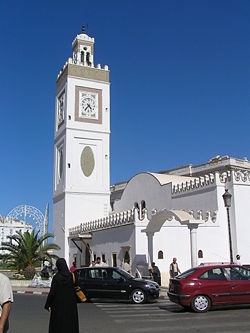
Modern Algerian literature, split between Arabic and French, has been strongly influenced by the country's recent history. Famous novelists of the twentieth century include Mohammed Dib, Albert Camus, and Kateb Yacine, while Assia Djebar is widely translated. Among the important novelists of the 1980s were Rachid Mimouni, later vice-president of Amnesty International, and Tahar Djaout, murdered by an Islamist group in 1993 for his secularist views. In philosophy and the humanities, Jacques Derrida, the father of deconstruction, was born in El Biar in Algiers; Malek Bennabi and Frantz Fanon are noted for their thoughts on decolonization; Augustine of Hippo was born in Tagaste (modern-day Souk Ahras); and Ibn Khaldun, though born in Tunis, wrote the Muqaddima while staying in Algeria. Algerian culture has been strongly influenced by Islam, the main religion. The works of the Sanusi family in pre-colonial times, and of Emir Abdelkader and Sheikh Ben Badis in colonial times, are widely noted. The Latin author Apuleius was born in Madaurus (Mdaourouch), in what later became Algeria.
The Algerian musical genre best known abroad is raï , a pop-flavored, opinionated take on folk music, featuring international stars such as Khaled and Cheb Mami. in Algeria itself the style: ( raï ) remains the most popular,but the older generation still prefer ("shaabi", Dahmane Elharrashi its King..) while the tuneful melodies of Kabyle music, exemplified by Idir, Ait Menguellet, or Lounès Matoub, have a wide audience. For more classical tastes, Andalusi music, brought from Al-Andalus by Morisco refugees, is preserved in many older coastal towns. For a more modern style, the English born and of Algerian descent, Potent C is gradually becoming a success for younger generations. Encompassing a mixture of folk, raï, and British hip hop it is a highly collective and universal genre.
Although " “ raï"". is welcomed and praised as a glowing cultural emblem for Algeria, there was time when raï’s come across critical cultural and political conflictions with Islamic and government policies and practices, post-independency. Thus the distribution and expression of raï music became very difficult. However, “then the government abruptly reversed its position in mid-1985. In part this was due to the lobbying of a former liberation army officer turned pop music impresario, Colonel Snoussi, who hoped to profit from raï if it could be mainstreamed.” In addition, given both nations’ relations, Algerian government was pleased with the music’s growing popularity in France. Although the music is ore widely accepted on the political level, it still faces severe conflictions with the populace of Islamic faith in Algeria.
In painting, Mohammed Khadda and M'Hamed Issiakhem have been notable in recent years.
Landscapes and monuments of Algeria
UNESCO World Heritage Sites in Algeria
There are several UNESCO World Heritage Sites in Algeria including Al Qal'a of Beni Hammad, the first capital of the Hammadid empire; Tipasa, a Phoenician and later Roman town; and Djémila and Timgad, both Roman ruins; M'Zab Valley, a limestone valley containing a large urbanized oasis; also the Casbah of Algiers is an important citadel. The only natural World Heritage Sites is the Tassili n'Ajjer, a mountain range.


